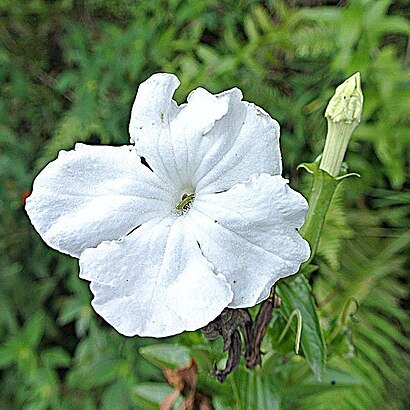into a raceme; peduncles stout, curved, scabrous, 1.5-3.0 mm long bearing 2 opposite ovate to linear bracts to ca. 7 mm long on the upper 1/2. Flowers with the calyx tubular, 3-5 cm long, with 3-6 irregular deltoid lobes 5-8 mm long, conspicuously 10-nerved in the lower 1/2, 5 or 10 nerved apically, glabrous to scabrous, sometimes pubescent only on the veins, sometimes appearing pustulate with hair bases; corolla white, tubular salverform, the tube slightly curved, 8-10 cm long, 8-15 mm wide near the apex, the limb spreading 3-6 cm across with 5 rounded lobes, puberulent outside and on the limb with short gland-tipped hairs, glabrous within the tube; stamens 4, the filaments slender, compressed, inserted about 1/2 way up the tube, ca. 1.5 mm free, ciliate, apically, the anthers alike, narrow, long sagittate with slender tails, 1.5 cm long, situated ca. 2/3 way up the tube, dehiscing by long, introrse slits, minutely apiculate; ovary narrow, glabrous, the style bent apically, pubescent at the stigmatic level, the stigma ca. 1.5 mm long, running along 1 side of the style, the final 5-7 mm sharply curved, enlarged, situated just above the anther tips. Capsule ca. 2 cm long; seeds 4.04.5 mm long.
More
Tall, perennial herbs; stems relatively slender, drying many sulcate, retrorsely scabridulous; roots conspicuously orange. Leaves opposite, ovate to narrowly deltoid, apically acute or obtuse, basally obtuse, truncate or slightly auriculate, the margins serrate with low, callose teeth, veins 5-7-digitate, impressed above, prominent beneath, the minor venation prominent beneath, stiffly coriaceous, scabrous with short, sturdy hairs on multicellular bases, the bases sometimes giving a pustulate appearance; petioles to 1 mm long or wanting. Inflorescences solitary, often geminate flowers in the upper leaf axils, sometimes aggregated
A herb. It grows erect and keeps growing from year to year. The stems are leafy and 60-150 cm long.
Uncommon plants of open sites, in marshy or wet situations of lower montane evergreen forest formations, at elevations of 1,000-1,500 metres in Costa Rica.
More
A tropical plant. It grows in tropical places. It is recorded between 1,100-1,500 m above sea level in Costa Rica.

